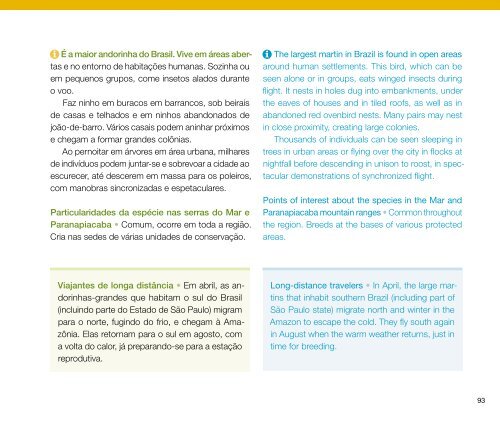Guia de aves Mata Atlântica Paulista - Secretaria do Meio Ambiente
Guia de aves Mata Atlântica Paulista - Secretaria do Meio Ambiente
Guia de aves Mata Atlântica Paulista - Secretaria do Meio Ambiente
Create successful ePaper yourself
Turn your PDF publications into a flip-book with our unique Google optimized e-Paper software.
É a maior an<strong>do</strong>rinha <strong>do</strong> Brasil. Vive em áreas abertas<br />
e no entorno <strong>de</strong> habitações humanas. Sozinha ou<br />
em pequenos grupos, come insetos ala<strong>do</strong>s durante<br />
o voo.<br />
Faz ninho em buracos em barrancos, sob beirais<br />
<strong>de</strong> casas e telha<strong>do</strong>s e em ninhos aban<strong>do</strong>na<strong>do</strong>s <strong>de</strong><br />
joão-<strong>de</strong>-barro. Vários casais po<strong>de</strong>m aninhar próximos<br />
e chegam a formar gran<strong>de</strong>s colônias.<br />
Ao pernoitar em árvores em área urbana, milhares<br />
<strong>de</strong> indivíduos po<strong>de</strong>m juntar-se e sobrevoar a cida<strong>de</strong> ao<br />
escurecer, até <strong>de</strong>scerem em massa para os poleiros,<br />
com manobras sincronizadas e espetaculares.<br />
Particularida<strong>de</strong>s da espécie nas serras <strong>do</strong> Mar e<br />
Pa ranapiacaba • Comum, ocorre em toda a região.<br />
Cria nas se<strong>de</strong>s <strong>de</strong> várias unida<strong>de</strong>s <strong>de</strong> conservação.<br />
The largest martin in Brazil is found in open areas<br />
around human settlements. This bird, which can be<br />
seen alone or in groups, eats winged insects during<br />
flight. It nests in holes dug into embankments, un<strong>de</strong>r<br />
the e<strong>aves</strong> of houses and in tiled roofs, as well as in<br />
aban<strong>do</strong>ned red ovenbird nests. Many pairs may nest<br />
in close proximity, creating large colonies.<br />
Thousands of individuals can be seen sleeping in<br />
trees in urban areas or flying over the city in flocks at<br />
nightfall before <strong>de</strong>scending in unison to roost, in spectacular<br />
<strong>de</strong>monstrations of synchronized flight.<br />
Points of interest about the species in the Mar and<br />
Paranapiacaba mountain ranges • common throughout<br />
the region. Breeds at the bases of various protected<br />
areas.<br />
Viajantes <strong>de</strong> longa distância • Em abril, as an<strong>do</strong><br />
rinhas-gran<strong>de</strong>s que habitam o sul <strong>do</strong> Brasil<br />
(incluin<strong>do</strong> parte <strong>do</strong> Esta<strong>do</strong> <strong>de</strong> São Paulo) migram<br />
para o norte, fugin<strong>do</strong> <strong>do</strong> frio, e chegam à Amazônia.<br />
Elas retornam para o sul em agosto, com<br />
a volta <strong>do</strong> calor, já preparan<strong>do</strong>-se para a estação<br />
reprodutiva.<br />
Long-distance travelers • In April, the large martins<br />
that inhabit southern Brazil (including part of<br />
São Paulo state) migrate north and winter in the<br />
Amazon to escape the cold. They fly south again<br />
in August when the warm weather returns, just in<br />
time for breeding.<br />
93

















